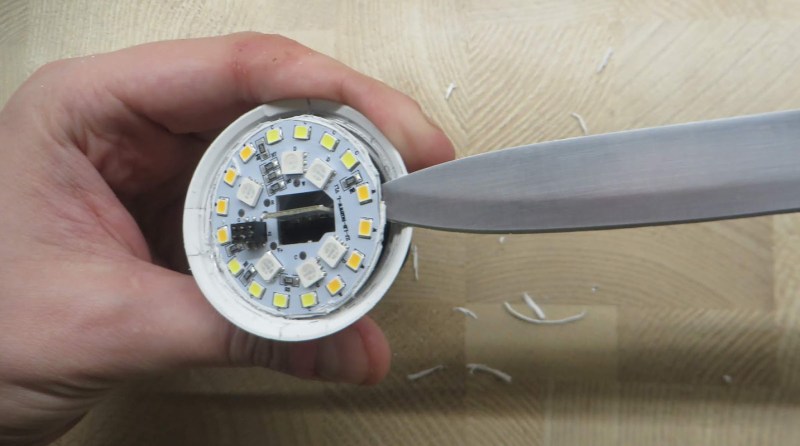The ESP32 and ESP8266 spread like wildfire a few years ago due to their small form factor, low price, and wireless capability. They didn’t just take over the DIY scene, though. Plenty of mass market products began to incorporate these tiny chips as well, which means that there are some interesting pre-made devices around that are ripe for modification. In this case, using an off-brand smart light bulb as a base for an semi-proprietary lighting setup.
The lighting in this build is a generic RGB light bulb with the ability to control its color over Wi-Fi. Since it has an ESP8266 chip in it, it can be made to work with Philips Hue lights with some minor modifications, allowing a much wider range of control than otherwise available. For this one, [Vadim] needed to pry open the bulb case to access the chip, then solder wires to it for reprogramming. It needed power during this step which meant plugging the resulting mess of wires back into a lamp socket, but after this step the new programming allows the bulb to be reprogrammed remotely.
After that step is complete, though, the generic bulb is ready for its inclusion into a Hue lighting system. In this case, [Vadim] is using diyHue, a Hue emulator that allows control of the bulbs without needing to use any cloud services, running on a BeagleBone. It’s a fairly comprehensive way of adding many different types and brands of bulbs to one system, and avoids any subscription models or the use of a cloud service, which is always something we can get behind.
















Be careful removing the PCB using the method shown above. I have a similar bulb here where one of the LEDs broke up in the process.
Doesn’t really look like there is a better way, its the current skill most in required for fixing modern electronics – the ability to handle a collection a spudgers and wedges all at once so you can carefully force open the glue/clip seams without damage (I think extra (and smaller) hands, or at least an extra thumb per hand could be quite handy every time I have to have a go)…
Or you just do the sensible thing an accept no matter how careful you try to be there will be some failures, so don’t waste too long being extra careful…
Just trying to provide a warning for the first time user. It would have helped me to know before my first, and so far only, attempt.
Very good point, along that line it is also worth pointing out that using a knife like that is a good way to insert it into your poor long suffering fingers, always better if you can to use a knife to clear the gunk enough to let the blunt spudgers get access.
Good advice; care is required. I wouldn’t want to have an increased resistance spot waiting to start a fire.
When I do this stuff I’m not reusing the plug, so I break the plastic near the bottom, and then I can scrape the glue off from below and I don’t have to torque the PCB.
Fire is real, and contrary to the popular shop myth, bold macho words does not prevent fire.
I flashed a lot of those cheap light ones OTA with tuya convert without a need to open them. Most of these are rebranded tuya devices. But beware the esp wasn’t cheap enough for tuya so they made their own pin compatible replacement which does not run the esp8266s firmwares.
“An semi”?
“For this one, [Vadim] needed to pry open the bulb case to access the chip, then solder wires to it for reprogramming. It needed power during this step which meant plugging the resulting mess of wires back into a lamp socket,”
>8-O
Eek! Not sure I’d want to try that!
110/240V straight into the programmer and bang goes the programmer and your laptop if you make a mistake.
Can’t you just power the ESP from a 5V/3v3 source using the programming wires or just add some extra wires for the VCC? Seems a bit dodgy to plug it into the light socket just to program it.
When I messed around with a Hue bulb did exactly that – powered from 3.3V for investgation. It worked fine and was far safer.
That remote looks like something from a 1960’s Zenith tee vee. The old space command.
There at lot more ways of getting off the cloud. If you switch to a different hub software like Home Assistant you can integrate all sorts of devices that use to require the cloud to all local.
1. If you have Hue, buy a Sonoff Zigbee bridge flash it with Tasmota, and connect it to Home Assistant you now can work with Hue, Ikea and most Zigbee devices.
2. Just what this article is talking about you can flush a lot of ESP8266 devices with Tasmota or ESPHome and your devices have much quicker response and you do not have to rely on the cloud.
Why not just use some shelly bulb off the shelf via MQTT?
“Not a hack.”